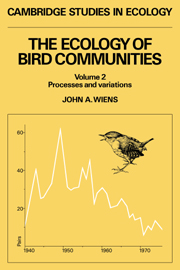Part III - Prospects
Published online by Cambridge University Press: 18 December 2009
Summary
During the past three decades, community ecology in general and avian community ecology in particular have undergone dramatic changes. The qualitative descriptions of community composition that characterized the 1950s gave way to the heady euphoria of the 1960s and early 1970s, when increasingly quantitative descriptions were linked with attractive conceptual or mathematical models of community structure and the role of competition in producing that structure. But then, during the mid-1970s, mutterings of dissatisfaction were heard here and there, and these increased to a sometimes chaotic clamor during the early 1980s. Investigations lost the unitary focus that competition-based community theory had provided and doubt in the validity of past studies or the wisdom of future studies of communities became widespread. Some investigators echoed the skepticism expressed in 1954 by Andrewartha and Birch, who had concluded that community studies were unlikely to contribute any understanding to the central questions of ecology.
Of necessity, much of my emphasis in this book and its companion volume has been on the problems of past studies and the inadequacies that have fueled this recent skepticism. In order to make progress in the difficult task of understanding how assemblages of organisms are put together and what processes act upon them, it has been necessary to examine where we have been and what we know versus what we only think we know. It would be easy to conclude that doing community ecology properly is an impossibly difficult task, that dealing with the logical problems and methodological pitfalls discussed in Volume 1 or the complicating effects of temporal and spatial variation detailed in Chapter 4 and 5 is an unattainable ideal.
- Type
- Chapter
- Information
- The Ecology of Bird Communities , pp. 249 - 250Publisher: Cambridge University PressPrint publication year: 1989

